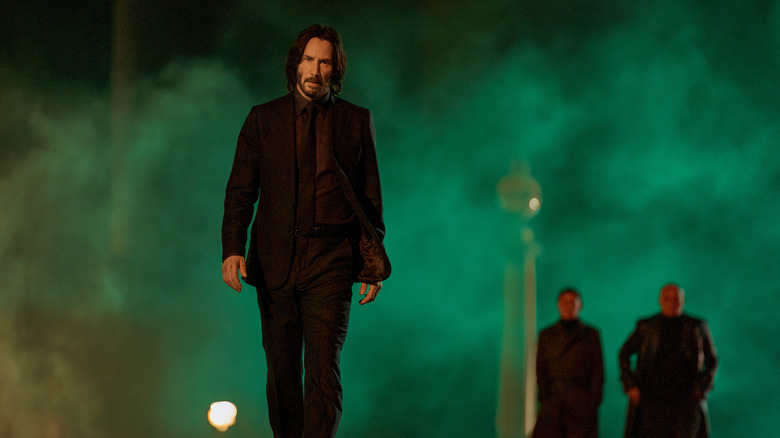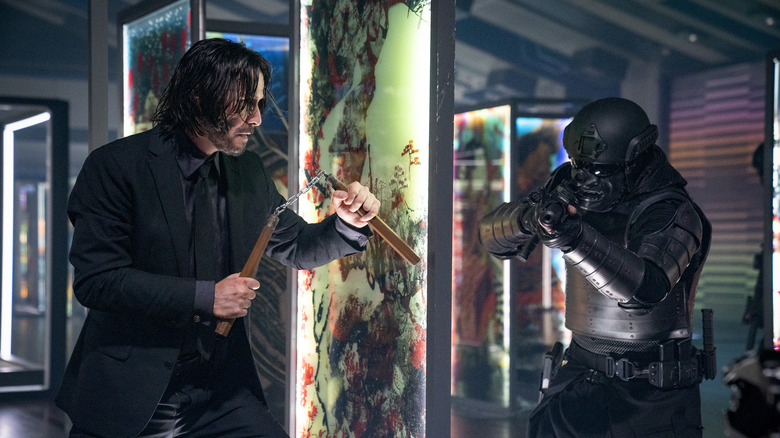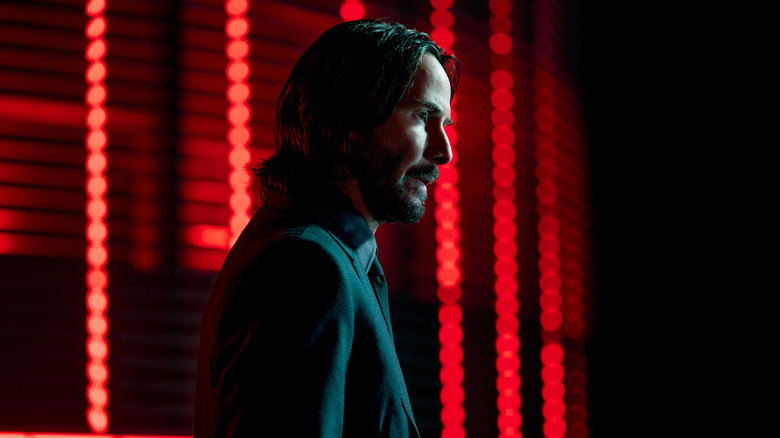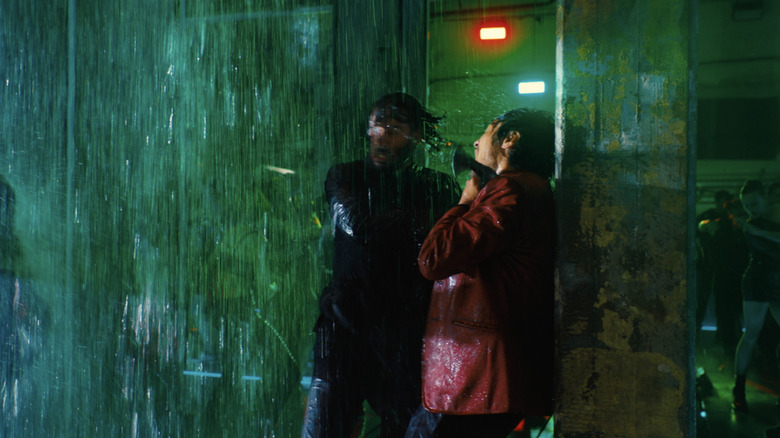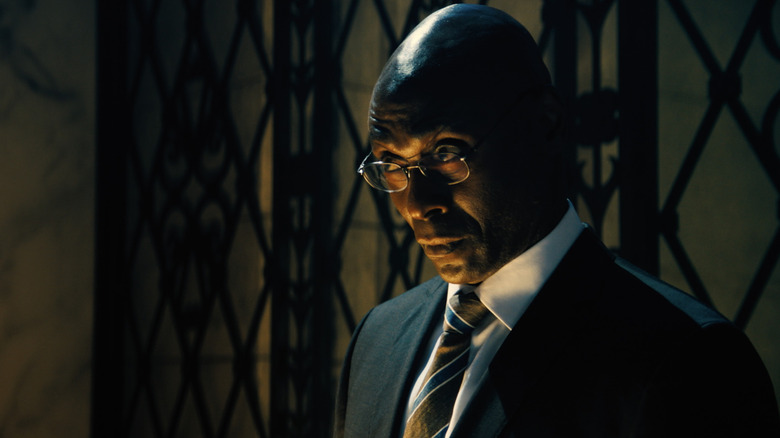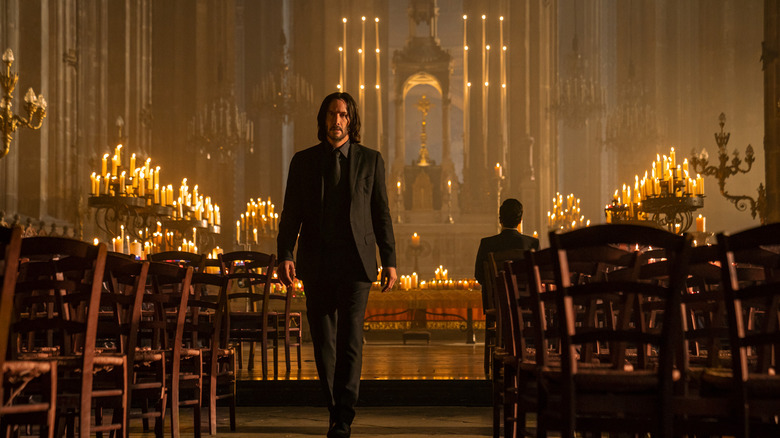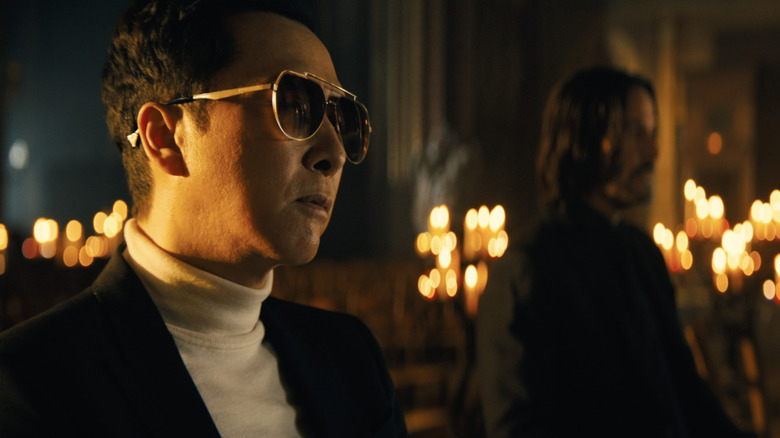John Wick: Chapter 4 Writers On Avoiding Exposition And Crafting A Menacing Villain [Exclusive Interview]
[Editor's note: This interview took place before Lance Reddick passed away on March 17.]
This post contains spoilers for "John Wick: Chapter 4."
The fourth installment in the "John Wick" franchise is now in theaters, and the Keanu Reeves-starring film succeeds in topping the already impressive films that came before it. The movie is correctly being hailed as having some of the most memorable and epic fight sequences ever to grace the big screen, but the film also doesn't shirk from giving us an understanding of Reeves' titular character.
"The struggle that Keanu has is, 'Am I John or am I John Wick?'" the film's co-writer, Michael Finch, told me in an interview alongside his fellow co-writer, Shay Hatten. "John Wick is fully under the thumb of the Table. John is a man who fell in love and had a relationship with this wonderful woman, Helen. We want the audience to understand that and get behind him and experience this with him. There's a dichotomy there. He wants John to be free."
My conversation with Finch and Hatten covered why John Wick's delivery is so laconic, the process for writing out those epic fight scenes line by line, why a certain character ended up dying, and more. Read on for our spoiler-filled discussion.
Note: This interview has been lightly edited for clarity and brevity.
'We get to explore what I think is a really interesting triumvirate'
Action movies in particular can sometimes spend too much time with plot over character, but in this movie, we see layers, especially of John Wick, that we haven't seen before. When you were tackling the script for the fourth film, was there anything you wanted to explore about the character or any throughline you wanted to make sure that you touched on when you were pulling it together?
Hatten: Yeah, for sure. I think one of the really interesting things we got to explore in this movie was just more of that implied backstory of John, because what we're always doing in these movies is he's meeting different characters who you realize he has a history with, but you're never totally clear on what it is.
Whether like Willem Dafoe in the first movie, where there's a fatherly relationship. Or Common, in the second movie, where you think they fought together at some point. But in this movie, we get to explore what I think is a really interesting triumvirate with John, and then the Donnie Yen character and the Hiroyuki Sanada character. These are guys who, we get the sense, without ever explaining how, that John knew them far in the past. He had adventures with them. He considered them to be like brothers to him.
I think really that implied backstory between these three guys lends the movie a lot of emotional texture that helps to define John's journey as he's continuing through this story. So to me, that's always the exciting thing is getting — through new characters — into implied backstory, where we can dig deeper into different levels of who John Wick is and who he was.
Finch: Everything was hand in hand — you have character servicing story and backstory. You have story servicing the action and the setup, and characters functioning within this chaotic action that [director Chad Stahelski] creates. By introducing a series of characters, many of whom know John Wick or know of John Wick, we get to explore the world in a non-expositional setting.
What we really wanted to avoid was exposition. We want to expand the world and the horizons of this world and the potential of this world without sitting you down and telling you exactly what this world was about. Shay and I have talked about this — the question is more interesting than the answer. These characters allow you to ask more questions about the world, which makes you think about it more. If you can walk out of that theater thinking about this, talking about this, it's a win for us.
'Writing a scene for Keanu is an exercise in redaction'
Another thing I was struck by is, and this is true for all the films, but especially in the beginning of "John Wick: Chapter 4," Keanu says very little. He's very laconic. When you're pulling the script together, how did you approach writing what John Wick would say? And was there any conscious effort to have it be as little as possible?
Finch: [Does John Wick impression] Yeah. Keanu is an actor who has the courage not to speak. Now, he has a look that he does on film when he looks at somebody, and it basically says, "I'm going to kill you next." He does that in person also, just to be clear. It's really quite disconcerting. It's like, "Please f***ing stop doing that. Please don't look at me that way." So yeah, he's a guy that does not want to speak.
The joy of this franchise, again, is its non-expositional nature. He doesn't sit there and tell you who he is, who he thinks he is, what he thinks the world owes him. He lets other people do that. He's not concerned with that, which makes it so potent. It's truly encompassed in that line that says he's not the boogeyman — he's the man you hire or send to kill the boogeyman.
Writing a scene for Keanu is an exercise in redaction. He's going to say as little as possible. He can sell the moment and he's going to essentially lean into the other characters to fill in that blank. It's incredibly powerful. It's one of the things I think that makes the Baba Yaga so dangerous. It's the scene in the first movie where Viggo calls him and [John Wick] listens and says absolutely nothing. Then he hangs up the phone and the other guy asks, "What did he say?" and Viggo says, "Enough." So writing for Keanu is figuring out how to craft a scene where he can have a physical presence without really saying much of anything.
Hatten: If a character tells you they're cool, you don't think they're cool. But if everybody else in the movie clearly thinks this guy is something to be feared and revered and has this attitude toward him, then you as an audience member, I think, gain that attitude.
Keanu knows that better than anybody. When I first started working on these movies, I would write too much dialogue for him, but Keanu would just know, "I don't need to say that to convey how badass and scary I am." So it really is just letting him lead by example by how well he knows the character.
Finch: Part of that is the fact that Keanu realizes that whenever he's shooting this movie, part of him believes he's John Wick. John Wick knows the rules of this world. He knows the players. He wouldn't say things, he wouldn't stop, look at the camera and explain to an audience, because there is no audience. He's actually living this moment. He's embraced the fantasy, which, by the way, he drags other actors into — they become their characters, largely. Which I think is one of the reasons the movie works so well, and it does really come from him and from Chad [Stahelski].
By treating us like adults, by not stopping the film to tell us what's going on, by making us catch up, and by letting us enjoy the moment without the background noise of exposition, he allows us to enter this world for a moment and peek over his shoulder. There's something very gratifying about that and very satisfying. And I've got to say, when I watch the early cuts, I'm like, "Oh, s***, is this going to work? Because he's not saying anything." But it does.
'I'd originally thought this was just chaos for chaos' sake'
What did you have on page in terms of when the action took place? You didn't have what happens line by line, right?
Finch: Well, we do actually write it line by line.
Oh, really?
Finch: Largely. Chad has a very specific vision and he wants it written out more or less the way he sees it. So you write it, then you rewrite it with him, and he gives you his notes. Eventually you go to the set, you see what the physical dimensions of the space are, where the intersections are, and you rewrite it, and everybody trains for that for three weeks. Then Chad shows up and says, "No, no, we're not doing it this way. We're doing it this way," and throws a wrench in the whole thing.
Now I'd originally thought this was just chaos for chaos' sake, but really there's a method to the madness. The method behind this madness is that Chad was a professional fighter. He's been lots of scraps. He's a very talented martial artist. He knows that fights never work out the way you want them to work out. So by going in there and taking a well-choreographed sequence, throwing a wrench in it and saying, "No, we're going to do it this way instead,"everybody suddenly has to react, and act, and be more spontaneous, and that actually shows up on film. It's a really interesting give and take. You have his idea where he wants the set, you write a sequence, he comes back with his notes, you tailor it to what he thinks he wants, you then go to the location and you tailor it to the location and what he wants. And then he blows it all up and shoots it. And then of course when we get to editing, they blow it up some more.
'It really did come out from making the Marquis want to seem like a threat right away'
I'm going to get spoilery here, but I wanted to talk about Lance Reddick's character and his untimely demise. Obviously it drives a lot of the story, but I would love to hear how that decision came to be.
Hatten: It was always a challenging thing because when you're writing one of these movies, you want to come up with an iconic villain, and somebody who really feels scary and represents the existential threat of this world. That isn't any individual assassin within this world — the bureaucracy of the High Table is really the greater evil, this system that won't let anybody go. That's why John is trapped. That's why we empathize with John. So in this movie, when we start figuring out this character of the Marquis, the Bill Skarsgård character, you want him to represent a threat and show what he can do initially. So it really came about from us wanting him to do something scary.
There were different versions of what that was going to be, what it was going to look like, maybe who was going to go, whether it was just going to be just The Continental being destroyed, at what point in the movie it was going to happen. But I think it really did come out from making the Marquis want to seem like a threat right away. But it does speak to, I think, how important Lance is to this franchise that it has the impact it does.
Finch: The single saddest thing that I personally was involved with was killing [Charon]. I think Chad and Keanu felt we needed to give a jumpstart or catalyst to the action of the piece. Lance obviously isn't entirely clean. Like everyone in this world, he functions in gray. He just happens to be a little closer to the light than some of the others. You genuinely like him as a human being because he's a wonderful human being, and you like him as this character, Charon. The collective decision was that we need something to make us really f***ing hate this Marquis, and what is going to make us hate him more than this? Blowing up a building ain't going to do it. Killing the least undecent person in this world — it was also a point that the Marquis didn't need to make, which speaks to the Marquis' sadism.
Hatten: It makes him nastier, because even if he'd taken Winston out in that moment, for instance, you would be like, "Well, Winston broke the rules." But the fact that he doesn't — he's making a point that he can do anything. I think that makes him really feel that much more nasty and duplicitous, and really makes you want to want to see John get him. So I hope it does accomplish that task of making us really root for the Marquis to meet his downfall.
Don't worry, the Marquis is fully unlikable in a wonderful way.
Finch: Skarsgård is the opposite. He's the most lovely human being, but my God, he can turn it. He gets that eye when he looks at you, and you're like, "No, no, no, no, not cool."
'We've been toying with this conceit of the distinction between John and John Wick'
Another scene I thought was a great addition and really gives John Wick that depth I was talking about before is when they're talking about epitaphs, and Wick says he wants "loving husband" on his tombstone, which was just such a great moment in terms of the character. How did that whole idea come about to have that, and then have it tie in at very end of the film?
Finch: We've been toying with this conceit of the distinction between John and John Wick, and this is something that Marquis keeps bringing up. So you think there's a happy ending, but there isn't. You think there's no John out there — there's only John Wick the killer. Even in the beginning of the piece, the Elder will say, "The only way out, for John Wick to be free, is through death."
The struggle that Keanu has is, "Am I John or am I John Wick?" John Wick is fully under the thumb of the Table. John is a man who fell in love and had a relationship with this wonderful woman, Helen. We want the audience to understand that, and get behind him and experience this with him. There's a dichotomy there. He wants John to be free. He recognizes that John Wick may have to die, and so how's he going to get out of this one? It's a trap.
So in a sense, that scene grew out of that, as did the scene at Charon's mausoleum. This was also built after we decided to kill Charon and we wanted to keep Charon's memory in the piece, because he is just such a fundamental aspect of the "Wick" film. So it really spoke to one of the two or three themes we're trying to get through on this piece.
'We wanted to highlight the fact that nothing is as it appears'
The scene between Donnie Yen and Keanu Reeves in the church and their back and forth before the final fight, can you talk about how that scene came to be and what you wanted to convey to the audience through that?
Finch: We wanted to convey to the audience that these are both inherently good men. Even though they do bad things, they're both inherently decent men and they're both here for non-obvious reasons. They're not just warriors. Caine is there for his daughter — to save his daughter, John Wick has to die. John is there to try and figure out how to free himself of John Wick. The opening line when Donnie essentially asks, "You're talking to your wife, do you think she can hear you?" John says no and Caine asks, "Then why bother?" And John says, "Maybe I'm wrong." It just speaks to how this entire franchise exists in a gray area with deep shadows.
The name of this film when we were producing was "Caravaggio," an artist who used shades and black and gray and whatnot. That's the world that John Wick exists in. With that scene, we wanted to highlight the fact that nothing is as it appears. These people are not necessarily acting for reasons that we think — it's not as simple as you think it is. It's a genre piece on a surface, yes. But actually there's more to it. It allowed these two guys, who are really both really good actors, to sit down for a moment and not have to be fighting.
Hatten: I think it's a great scene because it makes Caine a worthy adversary to John in a way that Bill Skarsgård isn't. I think Bill Skarsgård is an incredible antagonist, but he doesn't have honor. He doesn't have respect. He respects the rules and nothing else. Whereas Donnie and John are both doing this for love of different people. That makes them two people who, when they fight, it's more tense. Because unlike Bill, you're not rooting for John to kill Donnie — you empathize with Donnie and you want him to have his freedom as well. I think that scene, to me, crystallizes what makes it so exciting to see them go up against each other.
"John Wick: Chapter 4" is now playing in theaters.
